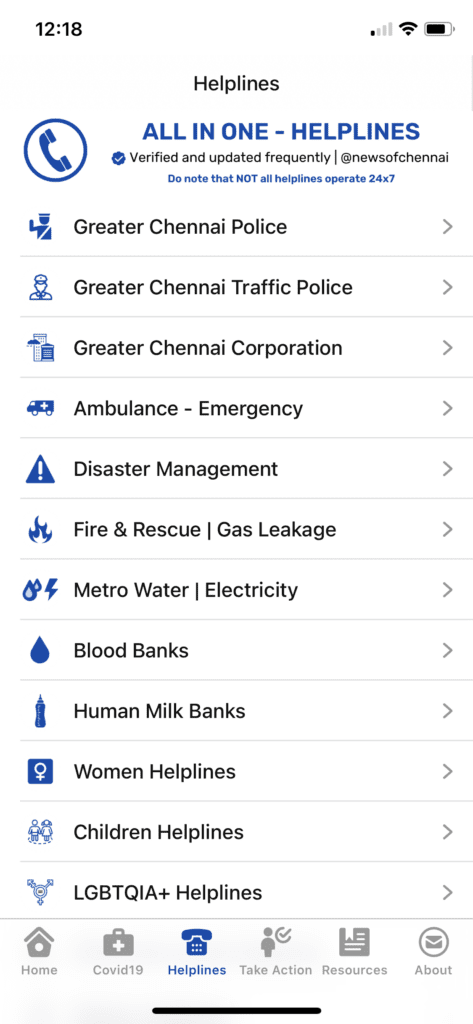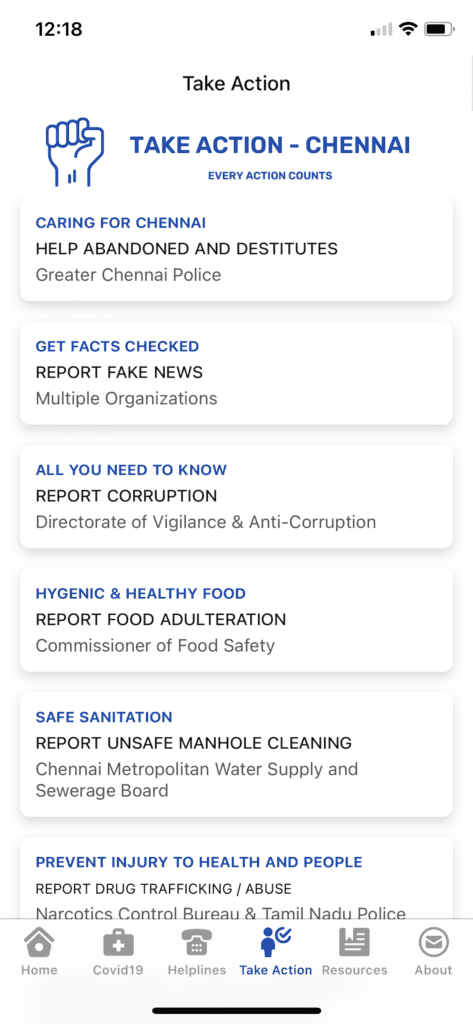As the entire world saw an upsurge in the number of COVID-19 cases during the first and second waves, the necessity for credible information was paramount. In March 2020, I started Covid19Chennai on Instagram and Twitter (rebranded as News of Chennai in 2021) to publish cross-verifiable, fact-checked information such as important helplines, home-based food providers, where to get tested, what to do if someone tests positive and curated FAQs related to COVID-19 from reliable news agencies.
This also gave me an idea to create chennaicovidhelp.in — a web app where all information would be collated. The advantage of a web app is that it does not need any download or update. It can be saved as an app on mobile as well as desktop. It is fast and secure and collects no data.
Need for credible, bite-sized information
The response to social media channels and web app motivated me to continue this effort whenever there was a need. When the Chennai floods happened in November and December 2021, I was able to share important information such as helpline and weather updates from IMD & reliable weather bloggers in a crisp form as a poster. The social media channels have more than 25,000 followers.
I realised that while social media was one channel to help citizens, my previous experience of creating a web app gave me an idea to create the News of Chennai app, envisioned as an all-in-one essential tool that would be useful for Chennai citizens. The app is set to go live on January 26, 2022 (Republic Day).
News of Chennai will only share information on what a Chennai citizen essentially needs to know. The service is not meant to be an alternative to established print or digital media, but rather derive crucial information from them and disseminate it in a concise form when there is a need. News of Chennai will not deliver breaking news unless there is a crisis where every citizen needs to be alerted, for example during calamities like floods or COVID-19.
Read more: 100, 101 or 1091: What to expect when you dial a helpline in Chennai
News of Chennai.App will thus empower Chennai citizens and visitors with essential verified information they may need. The app offers instant access to numerous verified helplines, how-to guides, resources, and suggestions to take action in Chennai. I firmly believe that as people start using the helplines and also take action in times of need, it will make our governments more accountable. The app encourages calls to action by providing the necessary information in one place.
Features of the app
There are different sections in the app which offer a variety of information:
Home section:
- Contains a short description about the app
- Important updates in the form of periodically-updated posters
- Dedicated page for medical emergencies, with the ability to call an ambulance, nearby hospitals to admit in-case of road accident, guides on what to do in case of burn, seizure, snake bite etc.
- Chennai-related news from reputed media houses and weather updates from weather bloggers as a curated Twitter list (there is no need to use twitter app, with newsofchennai.app this can be viewed)
- Redirects to the Important Helplines, Take Action, and COVID-19 pages
Helplines section:
- Contains an exhaustive list of helplines with one-touch call buttons and related resources
- All-year-round useful information
- Medical helplines, animal rescue operations, human milk banks and LGBTQIA+ organisations, among others
- Contains an option to report out-of-service helplines
Take Action section:
- Informs citizens about the actions which can be taken to create an impact in society
- Contains information about various government and non-governmental organisations in Chennai which assist in taking action
- Links to help abandoned and destitute people, report fake news and corruption, and sign up for organ donation, among others
Resources page:
- Contains must-know information for a Chennai citizen, like waste segregation guidelines, who administers public services and prevention of sexual abuse
- Contains how-to guides to birth and death registrations, filing an FIR and getting a community certificate, among others, sourced from Citizen Matters
- Routes and timings of all forms of public transport in the city
COVID-19 section:
- Contains all the updated resources related to COVID-19 in Chennai
- A separate page will be created for other important events and crises, e.g. Chennai rains.
- All related resources will be updated as soon as possible
About page:
- Description of the app
- FAQ
- Acknowledgements to the people who support the app
Read more: When we have 108 and 104, why do we need to call the police for health emergencies?
Sourcing, verification and updates
The information updated in the app and social media posters (@newsofchennai) is sourced from trusted sources like Tamil Nadu Government, Greater Chennai Corporation, Greater Chennai Police, journalists from reputed media houses and established non-governmental organisations. It also includes crowdsourced information which is verified before it is added to the app.
At the bottom of each page in the app, there is a footnote mentioning when that particular page was last updated. The aim is to update the app weekly. Just as new verified information shall be added, there is also a plan to remove outdated / irrelevant information. For example, once the third wave of COVID is over and the pandemic becomes endemic, a dedicated page for COVID will be removed and replaced. Whenever there is a need, a new page will be added so that all information is available in one place, for example during Chennai rains.
| Privacy policy: The app does not collect any user information as this is a public utility tool dedicated to Chennai citizens. Privacy is something I take seriously. There will be no ads or promotions ever.The app will be free forever. How can the app be accessed? Visit the link https://newsofchennai.app on your browser. A pop-up asks you to add the app to your home screen. Once done, the app appears on your home screen. Voila! The app works on any device such as mobile, tablet and laptop. This is a web app, so there is no need to download. It loads fresh every time with up to date information. Visual Guide on how install the app iOS – https://bit.ly/ios-newsofchennaiapp Android – https://bit.ly/android-newsofchennaiapp Users can write to newsofchennai@gmail.com for queries or additional information. |
Vision for the app
My vision is to see this app on everyone’s mobile phone and citizens accessing them whenever they need it.. There are a few more updates I am planning to add to the app such as mental health helplines, pet boardings, after death services. Currently, the focus is one single language i.e. English. However, it is our long term plan to make this app available in Tamil.
Funding is a challenge, however I believe this citizen service will garner donors to help me run the app in the long run.

